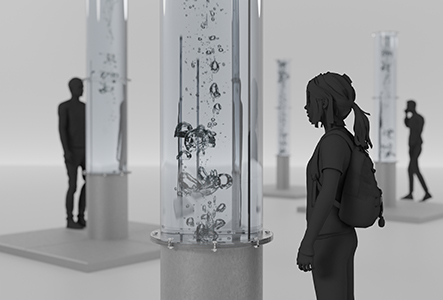Mark Hlawitschka talks about what bringing bubbles, adventure, and process engineering together can contribute to the Ars Electronica Festival.

Can you briefly describe your project?
Mark Hlawitschka: As part of the installation “The Sound of Bubbles, DO YOU FEEL STRESSED”, rising air bubbles create sounds in the water and form a soothing, almost mesmerizing soundscape that invite the listener to observe, listen and unwind. The sounds are picked up by underwater microphones and amplified. The stress-relieving installation makes playful use of the scientific phenomenon known as “multiphase-systems”. In addition, a smaller ‘adventure corner’ brings detailed phenomena closer in a playful way.
Where did the idea or inspiration come from?
Mark Hlawitschka: In the field of process engineering, multi-phase systems are everywhere. Both the particle size and hydrodynamics play a key role in directly influencing mass transport. At the Institute of Chemical Process Engineering, we are currently focusing on three-phase bubble columns (gas/liquid+catalyst), such as those used to support methanol synthesis. Whereas we use conventional measuring techniques to detect bubble size as part of two-phase systems, adding sound and artificial intelligence provide other exciting starting points. The project gives us initial insight into the world of bubble sounds, which is important for progress and advancements.
Who are the project team members?
Mark Hlawitschka: The project team is made up of people with different backgrounds. I felt it was particularly important to actively involve chemistry students as well as incorporate aspects of electrical engineering and computer science into the project. In addition, our successful collaboration with artist Moritz Simon Geist, particularly in regard to acoustic implementation and different control techniques, brought the project forward on many levels. While the set-up has a more industrial (scientific) look, the art has become a major aspect in the project and also resulted in some interesting discussions and revisions in regard to the set-up structure and design.
What does "A New Digital Deal" mean when it comes to your project; or, what would you like to see as part of a "New Digital Deal"?
Mark Hlawitschka: A New Digital Deal means combining measurements, data and algorithms in a targeted way in order to achieve added value, meaning a better understanding of the apparatuses and ultimately reducing CO2 emissions even more. At the same time, ‘A New Digital Deal’ provides direct links to education and opportunities to not only actively prepare students for new opportunities in academia, but also future industrial practices - we want to pursue these advancements together. By bringing different disciplines together, the set-up is a good starting point to start working on algorithms and better understand the apparatus, as well as use the acquired data to, for example, train the apparatus for different boundary conditions.
What can visitors look forward to most when they come to see your project?
Mark Hlawitschka: Visitors can look forward to a large, very impressive structure that rivals various aspects found at industrial plants. It combines a breath-taking world of tones with a play on colors. Kids will certainly enjoy exploring the small ‘adventure corner’.
What have been some of the greatest challenges when implementing your project? What was the biggest surprise?
Mark Hlawitschka: The greatest challenge involved working on the individual details. Not a week went by in which our technician, Johannes Huber, and our hard-working students, had to disassemble the first column, optimize it, and then reassemble it in order to put each and every detail together.







![[Translate to Englisch:] Mark Hlawitschka](/typo3temp/assets/images/csm_Hlawitschka_0a73bc80f6_5d842c4b62.jpg)

